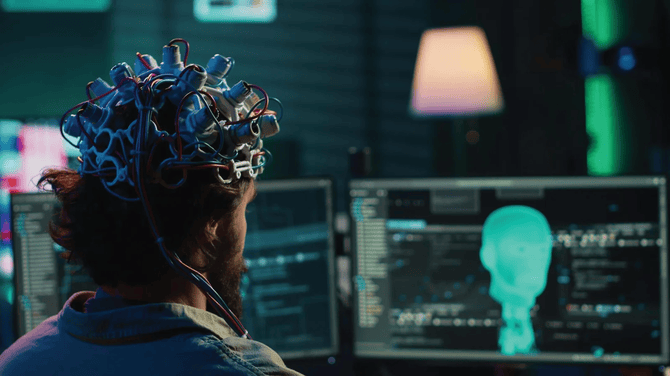Rapid advances in neuroscience, brain-computer interfaces, and cognitive monitoring are converging with educational technology in profound ways. The concept of using neurotechnology in learning environments promises to refine personalization, improve engagement, and deepen insight into how people learn. In this article we explore key Neurotechnology Trends in EdTech, examine how they intersect with the science of learning, and consider both the opportunities and challenges that lie ahead.
What We Mean by Neurotechnology in Education
Neurotechnology refers to technologies that monitor, interpret, or interact with brain activity. In an educational context these tools might include brain sensing headsets, neurofeedback systems, EEG, functional near-infrared spectroscopy, or brain-computer interfaces. When coupled with adaptive learning systems or analytics platforms, these allow insights into learner attention, emotional states, cognitive load, and much more. The fundamental idea is to augment traditional EdTech with data that reflects how the brain is working in real time, thereby enabling smarter personalization and better learning outcomes.
Emerging Trends in Neurotechnology for EdTech
One trend involves real-time brain monitoring to adjust learning pace or difficulty dynamically. Systems may detect learner fatigue or distraction and trigger an adaptive change in instructional flow. Another trend is integrating neurofeedback loops: learners receive feedback on their neural states and can learn to self-regulate attention or stress. Brain-computer interfaces are evolving to allow direct interaction via neural signals, especially for learners with disabilities. Also machine learning models are being trained on neural data combined with behavior to predict which pedagogical interventions will be most effective. Hybrid systems combining physiological signals (heart rate, skin conductance) with neural data strengthen inference about states like engagement. Finally collaborative neurotechnology in group learning environments is emerging—monitoring synchrony across learners’ brain patterns to enhance cooperative learning design.
How These Trends Align with the Science of Learning
The science of learning draws on principles from cognitive psychology, neuroscience, and education theory. Key constructs such as attention, working memory, cognitive load, retrieval practice, spacing, and feedback are central. Neurotechnology trends map directly onto those constructs by offering real-time indicators of cognitive load or attention, enabling adaptive feedback, optimizing intervals based on neural markers, and personalizing retrieval schedules. In this way, neurotechnology becomes a bridge between abstract learning theory and data-driven application. As students engage, neural signals can supplement behavioral metrics to refine models of how learning actually occurs in each unique brain.
Benefits and Potential Impacts on Learners and Educators
Learners may benefit from more finely tuned adaptive instruction that responds not only to test performance but to cognitive state. This could reduce frustration, boredom, or overload by pacing instruction more precisely. Educators and instructional designers gain a deeper window into hidden dimensions of learning, enabling intervention before learners fall behind. Over time such systems may help reduce dropout, improve retention, and foster self-regulation skills. Institutions may differentiate themselves through more effective learning experiences and yield better outcomes that attract learners. The promise is not just incremental improvement but transformation in personalization and responsiveness.
Ethical, Privacy, and Practical Challenges
Introducing neurotechnology into educational settings raises profound ethical questions. Who owns the neural data? How is consent managed, especially with minors? What limits on usage and sharing should exist? Privacy and data protection must be rigorous. Practically, neural signals are noisy, individual variation is large, and the technology can be expensive and intrusive. Integration into real classrooms requires wearability, minimal disruption, and robustness. Biases in algorithms trained on limited demographics must be guarded against. Stakeholder acceptance is essential—teachers, parents, learners may resist perceived surveillance or intrusion.
Strategies for Adoption and Implementation
Successful adoption begins with pilot projects in controlled environments to validate value. Partnerships among neuroscientists, educators, technologists, and ethicists help navigate interdisciplinary complexity. Start with low-stakes applications such as attention monitoring or self-regulation training rather than high-stakes assessment. Focus on use cases with clear value propositions for learners or teachers. Ensure transparent communication, consent mechanisms, and data governance frameworks. Design for scalability by emphasizing usability, cost management, and interoperability with existing EdTech systems. Continuous evaluation and iteration are essential to refine the technology in live classroom contexts.
Case Studies and Early Applications
Some universities and research labs are experimenting with EEG headsets to monitor student engagement during lectures, adjusting pacing or interactive prompts. In skill training environments or simulations neural feedback is used to help learners modulate stress or focus, especially in high-stakes or technical domains. Inclusive education applications use brain-computer interfaces to aid learners with motor impairments, enabling control or communication via neural intent. Corporate training pilots have combined neurofeedback with VR modules to improve focus and retention. These early applications offer lessons about wearability, user acceptance, signal quality, and integration challenges.
Future Outlook and Best Practices
Moving forward, neurotechnology in EdTech will likely evolve toward lighter, more affordable devices and more robust algorithms for interpreting signals across populations. Hybrid multimodal systems combining neural, physiological, and behavioral data will gain traction. Standards for data exchange and interoperability with learning management systems will emerge. Ethical frameworks and regulatory guidelines will also mature, guiding responsible use in education. Best practices include centering learner autonomy, maintaining transparency, and iterating in real settings. The most promising trajectories balance innovation with trust, privacy, and pedagogical soundness.
For More Info https://bi-journal.com/neurotechnology-trends-in-edtech-and-science-of-learning/
Conclusion
Neurotechnology trends in EdTech are ushering in a new frontier where learning becomes more intimately responsive to how our brains operate. When thoughtfully integrated, these trends hold the potential to enrich personalization, accelerate learning, and empower learners and educators with insights that were once hidden. Yet the path is fraught with technical, ethical, and practical challenges that demand careful navigation. The future of education may well be shaped by how wisely we marry neuroscience with pedagogy, ensuring that advances drive equity, agency, and deeper learning rather than mere novelty.

